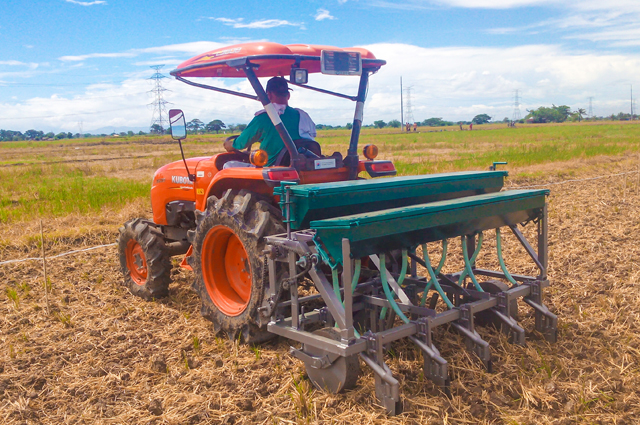The Philippines
July 12 ,2016

Sowing rice seeds in straight rows directly into the soil is now made easier with the reduced-till planter.
As the name connotes, the reduced-till planter works in minimally prepared soil at a predetermined seeding rate, with an option to simultaneously apply basal fertilizer. The machine can also be used to plant other crops such as maize, soybean, and mungbean.
The machine is a product of collaboration among the DA National Rice Program, Bureau of Agricultural Research (BAR), and the Philippine Rice Research Institute (PhilRice). They are working on emerging technologies under the Food Staples Sufficiency Program to increase farm productivity, and promote sustainability and adaptability of rice against the changing climate.
PhilRice team lead Dr. Manuel Jose Regalado of the project Accelerating the development and dissemination of associated rice production technologies that are resource-use efficient, said that the machine is not only designed to ease field operations in rainfed production areas, but also to establish the rice crop using less water while conserving soil moisture.
“There are more than 2M ha of rainfed rice lands in the country that can greatly contribute to reach the pressing demand for rice sufficiency. With the changing climate, farmers in these areas need to establish their crops quickly at the onset of the rainy season,” Regalado explained.
Efficiency at work
The reduced-till planter was developed and tested at the PhilRice Central Experiment Station (CES) in Maligaya, Science City of Munoz, Nueva Ecija for two planting periods, 2015 wet season and 2016 dry season. It was compared with the push-type seeder and the broadcast method, and evaluated in terms of grain yield.
The machine is rear-mounted to a compact four-wheel tractor and can seed nine rows at a time. Under clay loam soils, tilling is not needed. However, for heavy clay soils, such as the Maligaya clay series at PhilRice CES, reduced tillage (one-pass rotavation), is recommended. With this planter, seeds can be sown under the dry soil surface.
“Through this process, farmers can conserve 50% of the water requirement because land soaking is not needed,” said Kristine Pascual, PhilRice engineer and project team member.
Aside from seed planter, the machine can also be used to simultaneously apply basal fertilizer, if the farmer opts to do so.
Outcomes desired
With promising results, this new technology is being eyed for further studies on farmers’ sites.
Under rainfed condition and reduced tillage, the reduced-till planter attained a 300-500 kg/ha yield advantage compared to the push-type seeder and broadcast method.
With a 2-meter effective width, it can directly seed 2-3 ha/day. The seeding rate can be adjusted from 20-60 kg/ha.
“Given these results, we are aiming to bring the machine to farmers’ fields for further evaluation. We plan to conduct adaptive testing during the 2016 wet season and 2017 dry season,” Regalado said.
- See more at: http://www.philrice.gov.ph/sow-seeds-straight-rows/#sthash.kP6SuMvo.dpuf